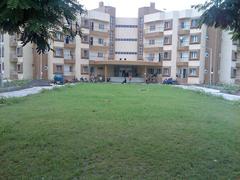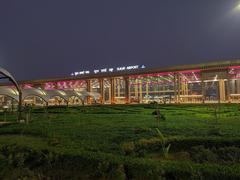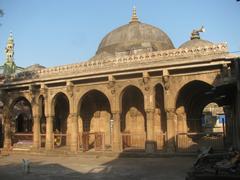Visiting MD Road in Surat: Hours, Tickets, and More
Date: 18/07/2024
Introduction
MD Road in Surat, also known as Mahidharpura Road, encapsulates the rich commercial and cultural heritage of one of India’s fastest-growing cities. Tracing its roots back to the early 17th century, MD Road has evolved from a bustling trading hub during the Mughal era to a vital artery in Surat’s diamond and textile industries today. The road’s historical significance is palpable, with architectural remnants from the Mughal and British colonial periods still standing as a testament to its storied past. In modern times, MD Road has maintained its relevance, continuing to serve as a crucial center for commerce, particularly in the diamond trade, where Surat processes over 90% of the world’s diamonds (Surat Municipal Corporation). This guide provides a comprehensive overview of MD Road, covering its historical journey, cultural and economic significance, visitor tips, and more.
Table of Contents
- [MD Road Surat - A Historical Journey Through Time and Commerce](#md-road-surat---a-historical-journey-through-time-and-commercemd-road-surat---a-historical-journey-through-time-and-commerce)
- [Introduction](#introductionintroduction)
- [Early Beginnings](#early-beginningsearly-beginnings)
- [Mughal Era](#mughal-eramughal-era)
- [British Colonial Period](#british-colonial-periodbritish-colonial-period)
- [Post-Independence Era](#post-independence-erapost-independence-era)
- [Modern-Day Significance](#modern-day-significancemodern-day-significance)
- [Cultural and Architectural Heritage](#cultural-and-architectural-heritagecultural-and-architectural-heritage)
- [Economic Impact](#economic-impacteconomic-impact)
- [Visitor Information](#visitor-informationvisitor-information)
- [Future Prospects](#future-prospectsfuture-prospects)
- [FAQ](#faqfaq)
- [Conclusion](#conclusionconclusion)
MD Road Surat - A Historical Journey Through Time and Commerce
Early Beginnings
MD Road, also known as Mahidharpura Road, is one of the most historically significant streets in Surat, India. The origins of MD Road can be traced back to the early 17th century when Surat was a bustling port city under the Mughal Empire. Surat’s strategic location on the banks of the Tapi River made it a vital trading hub, attracting merchants from across the globe, including the Portuguese, Dutch, and British.
Mughal Era
During the Mughal era, Surat flourished as a center of commerce and culture. The city was known for its textile industry, particularly its fine silk and cotton fabrics. MD Road, situated in the heart of the city, became a focal point for trade and commerce. The road was lined with shops and warehouses where merchants conducted business and stored their goods. The Mughal influence is still evident in the architecture of some of the buildings along MD Road, with their intricate designs and ornate facades.
British Colonial Period
The British East India Company established its first factory in Surat in 1612, marking the beginning of British influence in the region. By the mid-18th century, the British had gained control over Surat, and the city became an important administrative and commercial center for the British Raj. MD Road continued to thrive as a commercial hub, with British merchants setting up their businesses alongside local traders.
The British introduced several infrastructural developments in Surat, including the construction of roads, railways, and ports. MD Road benefited from these developments, becoming more accessible and further cementing its status as a key commercial artery in the city. The road also saw the establishment of several colonial-era buildings, some of which still stand today as a testament to Surat’s colonial past.
Post-Independence Era
After India gained independence in 1947, Surat underwent significant changes. The city experienced rapid industrialization and urbanization, transforming it into one of India’s fastest-growing cities. MD Road continued to play a crucial role in the city’s commercial activities, with new businesses and industries setting up along the road.
In the post-independence era, Surat emerged as a major center for diamond cutting and polishing. MD Road, located in the Mahidharpura area, became synonymous with the diamond trade. The road is home to numerous diamond trading offices, workshops, and showrooms, making it a bustling hub for the diamond industry. Surat’s diamond industry accounts for a significant portion of the world’s diamond cutting and polishing, and MD Road is at the heart of this thriving industry.
Modern-Day Significance
Today, MD Road remains one of the most important commercial streets in Surat. The road is a vibrant mix of old and new, with historic buildings standing alongside modern commercial establishments. The diamond trade continues to dominate the area, with MD Road being a key destination for diamond traders and buyers from around the world.
In addition to the diamond industry, MD Road is also known for its textile markets. Surat’s textile industry, which dates back to the Mughal era, continues to thrive, and MD Road is home to several textile shops and markets. The road is a popular destination for both locals and tourists looking to purchase high-quality fabrics and garments.
Cultural and Architectural Heritage
MD Road is not just a commercial hub; it is also a repository of Surat’s rich cultural and architectural heritage. The road is dotted with historic buildings that reflect the city’s diverse cultural influences. One notable example is the Dutch Garden, a beautifully landscaped garden that dates back to the Dutch colonial period. The garden is located near MD Road and is a popular spot for visitors looking to explore Surat’s colonial history.
Another significant landmark near MD Road is the Surat Castle, also known as the Old Fort. Built in the 16th century by Sultan Mahmood III, the fort is a testament to Surat’s strategic importance as a port city. The fort has been meticulously preserved and is now a popular tourist attraction, offering visitors a glimpse into Surat’s rich history.
Economic Impact
MD Road’s significance extends beyond its historical and cultural heritage; it also plays a crucial role in Surat’s economy. The road is a major center for trade and commerce, contributing significantly to the city’s economic growth. The diamond and textile industries, both of which are centered around MD Road, are major contributors to Surat’s economy, providing employment to thousands of people and generating substantial revenue.
The road’s strategic location in the heart of Surat makes it easily accessible, attracting businesses and investors from across the country and beyond. The continuous flow of goods and people along MD Road has helped to sustain the city’s economic momentum, making it one of the most prosperous areas in Surat.
Visitor Information
- Visiting Hours: MD Road is accessible 24/7, but the best time to visit is during business hours, typically from 10 AM to 8 PM.
- Tickets: There are no entry fees for MD Road itself, but some attractions like Surat Castle may have nominal ticket prices.
- Travel Tips: Wear comfortable walking shoes and be prepared for crowds. It’s advisable to carry some cash as not all shops may accept credit/debit cards.
- Nearby Attractions: Dutch Garden, Surat Castle, and the Textile Market are must-visit spots near MD Road.
- Accessibility: The road is well-connected by public transport, including buses and auto-rickshaws. However, traffic can be heavy, so plan accordingly.
Future Prospects
As Surat continues to grow and develop, MD Road is poised to remain a key player in the city’s commercial landscape. The road’s rich history, combined with its modern-day significance, makes it a unique and dynamic part of Surat. Efforts are being made to preserve the historic buildings along MD Road while also accommodating new developments and businesses.
The Surat Municipal Corporation has undertaken several initiatives to improve the infrastructure and amenities along MD Road, ensuring that it remains a vibrant and thriving commercial hub. With its blend of history, culture, and commerce, MD Road is set to continue playing a pivotal role in Surat’s future.
FAQ
- What is the best time to visit MD Road?
- The best time to visit MD Road is during business hours, typically from 10 AM to 8 PM.
- Are there any entry fees for MD Road?
- There are no entry fees for MD Road itself, but some attractions like Surat Castle may have nominal ticket prices.
- What are some must-visit spots near MD Road?
- Dutch Garden, Surat Castle, and the Textile Market are highly recommended.
- Is MD Road accessible by public transport?
- Yes, MD Road is well-connected by public transport, including buses and auto-rickshaws.
Conclusion
MD Road is more than just a street; it is a living testament to Surat’s rich history, vibrant culture, and thriving commerce. Whether you’re a history buff, a shopping enthusiast, or a curious traveler, MD Road offers something for everyone. To learn more about MD Road and other historical sites in Surat, visit the Surat Municipal Corporation’s official website.
References
- MD Road Surat - A Historical Journey Through Time and Commerce, 2024, Unknown Author (Surat Municipal Corporation)


